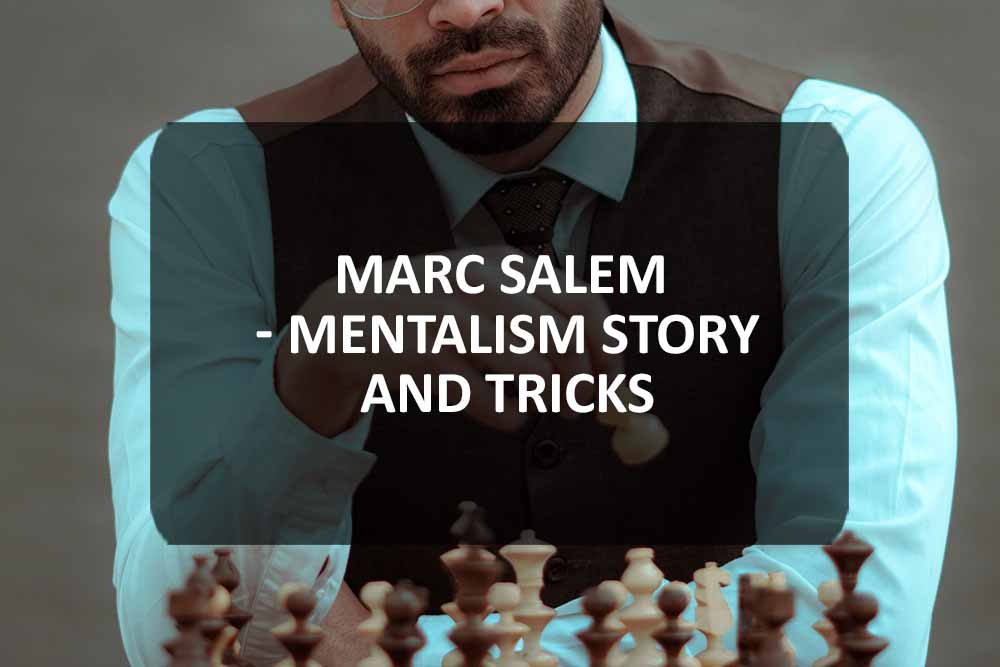If you’re interested in mentalism, it’s always great to learn about the mentalism greats.
Today, we’ll be directing our focus on Marc Salem.
If you’re a fan of the man himself or just want to learn how he made it, this article is for you. We’re going to look at his journey to becoming a world-famous mentalist.
Plus, we’ll talk a bit about Salem’s tricks and tips.
So let’s get started!
Who is Marc Salem?
Marc Salem may be known for being a mentalist, but this guy wears a lot of other hats.
Other than traveling the world to hold his show, Mind Games, Salem is also an author, researcher, and professor in various renowned universities.
As an academic, he has several advanced degrees from NYU and the University of Pennsylvania. He’s also a researcher and director of the Children’s Television Workshop.
We could say that Marc Salem is one of the most talented people out there.
But this talent is the fruit of many, many years of focus and interest in the world of non-verbal communication.
For the past 30 years, Salem has nurtured his enthusiasm in learning about behavioral cues, which is what he uses in his mentalism tricks.
What’s more, he has practiced an in-depth knowledge of psychological behaviors and uses this knowledge in influencing the behavior of his audience.
Needless to say, Salem has that natural charm and wit that makes audiences lean in and take part in his shows.
Check out this video of Marc Salem’s talk and performance:
Salem’s Journey to Mentalism
Did you know that Marc Salem wasn’t always called as such?
Yup, his real name is Moshe Botwinick, born to Jewish parents in Philadelphia.
His father was a rabbi. Salem recognizes that his being able to incorporate psychology into his observations was brought about by his father being able to easily “read” people.
Hence, observing people’s behavior was very natural for him even at a young age.
He tells in an interview that even when he was young, he could tell when his parents were going to surprise him. And it was all because they had certain behaviors that made surprises so obvious.
But despite this natural inclination in psychology, Marc Salem still attributes his skills to what he learned in school.
He took up psychology in college and continued to take a Ph.D. in it. He trained Ray Birdwhistell, the founder of non-verbal communication.
During graduate school, he was already giving corporate talks and lectures on negotiating and getting what you want.
This was when his journey to mentalism started.
After hours of studying, he decided to try his hand at mentalism.
But if anyone asked him if he was doing any sort of magic, Salem would deny it and tell you that he just knows the non-verbal cues. After all, he is a well-known psychologist.
Marc Salem Tips on How to Know if Someone is Lying
And now for the fun part. I mentioned earlier that we’re going to learn a few tricks Marc Salem is known for.
Let’s start with this – how to know if someone is lying.
Unusual/Off Actions
One of the easiest ways to spot a liar is to notice their movement.
Someone who isn’t comfortable with lying will tend to do a few things that aren’t natural to them. Or, they will do some involuntary reactions in response to that lie.
One of the most common things they can do is scratch their chin, nose, ear, or jaw. They might also attempt to stroke it.
Another action that liars often do is shift their weight from one foot to another. In reality, you don’t usually do this, but if you’re uncomfortable with lying, this movement will somewhat “ease” the discomfort you have.
Of course, another behavior they might do is avoid eye contact. Now, this is popular among a lot of liars.
When someone is lying, they will usually avoid eye contact for fear that their lie will be discovered. If you just stare into their eyes, they will quickly break their gaze and look somewhere else.
Involuntary Movements
Involuntary movements are different from the actions mentioned above because the former are those that your audience won’t even notice they’re doing.
So unlike the scratching and breaking one’s gaze, involuntary movements happen as a reaction to lying. Those who aren’t used to lying will most likely exhibit one or two of these movements.
Most of the time, the true emotion of a person will flash the moment they start lying. It can be a brief shock, embarrassment, or anger.
So when you’re talking to a person while performing mentalism tricks, you must pay attention to their face.
Just as Marc Salem does, he looks directly at the person and puts his full attention on them when they talk.
Here’s another one – a cracking voice. When your voice cracks, it’s sometimes because of nervousness or anxiety.
And when you’re lying, these feelings might show up even if you try so hard to conceal them. A cracking voice might be a sign of lying, but don’t take this too literally because it can also be mistaken for nervousness.
Finally, people might blush. It’s not obvious for some people, so I suggest looking for other signs to validate a lie.
But when it comes to involuntary actions, blushing is one of them. Blushing is a response to increased temperature in the body which could be caused by discomfort from lying.
Conclusion
As a person who looks at psychological responses and behaviors, Marc Salem uses this knowledge to spot liars or to find answers from his audience.
As a learning mentalist, you can always start from these tricks so that you can better gauge how to respond to your audience.
And if you haven’t noticed it yet, keep practicing. Remember, anyone can be able to spot a liar if they put a lot of work into it.
So to anyone learning how to mind-read the way Marc Salem does, I suggest that you can start by mastering these tricks in order to spot a liar.

